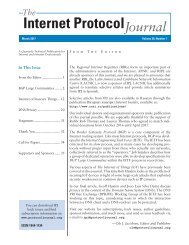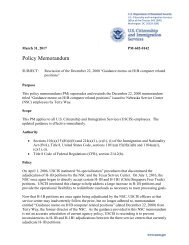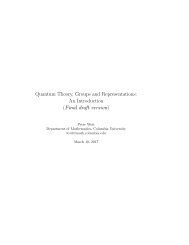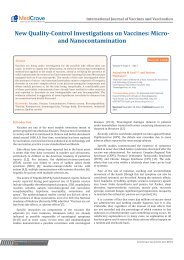THE HISTORY OF CVC
2nruRFS
2nruRFS
You also want an ePaper? Increase the reach of your titles
YUMPU automatically turns print PDFs into web optimized ePapers that Google loves.
ising in number from 28 in 1982<br />
to 76 in 1988. Some corporations<br />
made direct VC-style investments<br />
outside of any dedicated <strong>CVC</strong> fund;<br />
corporates made 245 such deals in<br />
1985, up from 30 in 1980.<br />
• Others pursued more idiosyncratic<br />
strategies. Eastman Kodak, for<br />
example, used a significant percentage<br />
of its $80M <strong>CVC</strong> fund to finance<br />
internally developed employee<br />
ideas that fell outside of its core<br />
business.<br />
The motivations behind the second<br />
wave of corporate venture capital<br />
largely mirrored those of the first:<br />
companies wanted access to<br />
technology, sometimes as means for<br />
diversification or sometimes to expand<br />
into adjacent product lines, albeit in<br />
a more disciplined, less wide-ranging<br />
fashion than during the first wave of<br />
<strong>CVC</strong>, rationalizing that <strong>CVC</strong> was often<br />
cheaper and more profitable than<br />
outright acquisition.<br />
Access to technology could also<br />
mean protecting or hedging against<br />
existing technologies. When the tech<br />
industry was looking for alternatives to<br />
silicon-based chips, Analog Devices, a<br />
maker of silicon-based chips, started<br />
a <strong>CVC</strong> program to invest in competing<br />
technologies. No alternative was found<br />
and Analog Devices’ investments<br />
largely failed — but the company would<br />
have been well-positioned had an<br />
alternative emerged.<br />
Given some of these motivations, the<br />
parent corporate’s strategies were<br />
not always beneficial for the startups<br />
they invested in. General Motors, for<br />
example, invested in five machine<br />
vision companies in order to create<br />
technology that could automatically<br />
inspect parts on the assembly line.<br />
The company pushed these companies’<br />
product development strategy to meet<br />
GM’s needs until finally they decided to<br />
abandon the tech and cut spending on<br />
the products, effectively abandoning<br />
the companies.<br />
<strong>CVC</strong> expands it reach<br />
While the second wave of <strong>CVC</strong> was<br />
largely focused on the technology<br />
industry, this was not exclusively the<br />
case. Colgate, Raytheon, and GM, for<br />
example, had <strong>CVC</strong> programs. General<br />
Electric still had its <strong>CVC</strong> fund from the<br />
first wave and invested in a number<br />
of successful tech startups. Xerox,<br />
Johnson & Johnson, Dow, WR Grace,<br />
and Motorola likewise maintained <strong>CVC</strong><br />
programs from the first wave.<br />
There were also a number of robust<br />
<strong>CVC</strong> investors among metal and<br />
chemical companies, such as Dow<br />
and WR Grace. One of the most<br />
active <strong>CVC</strong> investors of the period<br />
was Lubrizol Corporation, a chemical<br />
company, which invested in, among<br />
other companies, Genentech, which<br />
was backed by Kleiner Perkins Caufield<br />
& Byers and was one of the giant exits<br />
of 1999, when it went public with a<br />
$10.8B valuation.<br />
In addition, the second wave of <strong>CVC</strong><br />
was when, for the first time, foreign<br />
companies, especially from Japan,<br />
instituted <strong>CVC</strong> programs as well,<br />
although the investment was still<br />
largely confined to the US. Japanese<br />
companies made 60 investments in<br />
US-based companies in 1989, and their<br />
share of US-based <strong>CVC</strong> programs rose<br />
to 12% from 3% in 1983.<br />
By 1990, there were 138 corporate<br />
investors in European VC funds,<br />
although only a few European<br />
corporates had internally managed<br />
<strong>CVC</strong> funds.4<br />
Mark Radtke of consulting firm Venture<br />
Enterprises told The New York Times<br />
in 1986 that foreign corporations<br />
viewed VC as “an easy way … to effect<br />
a technological transfer,” i.e. gain<br />
access to new American technology.<br />
There was also some investment<br />
flowing in the opposite direction.<br />
For example, Monsanto, DuPont,<br />
3M, IBM, and Apple teamed up to<br />
create a client-based fund focused<br />
on European investments.<br />
Hedging against the past:<br />
Xerox Technology Ventures<br />
One of the most prominent corporate<br />
investors of the second wave was<br />
Xerox, then one of the most cutting-edge<br />
companies in Silicon Valley,<br />
partly because of its famous Palo Alto<br />
Research Center (PARC).<br />
Xerox Parc, 2003<br />
Xerox had had an active <strong>CVC</strong> program<br />
since the 1960s, operating an internally<br />
managed fund that invested in some<br />
of the most legendary figures in Silicon<br />
Valley, including Raymond Kurzweil<br />
and Steve Jobs. Kurzweil got his start<br />
in technology when Xerox invested in<br />
his first company, Kurzweil Applied<br />
Intelligence Inc., in 1982, to develop a<br />
computer that could transcribe spoken<br />
English. The idea behind the investment<br />
was to create technology that<br />
would increase demand for Xerox’s<br />
printing products when it ultimately hit<br />
the market.<br />
When Apple released its revolutionary<br />
Macintosh computer, some observers<br />
claimed that it had commercialized<br />
technologies first developed at Xerox<br />
PARC, such as the mouse, windows,<br />
212 292 3148 info@cbinsights.com cbinsights.com















